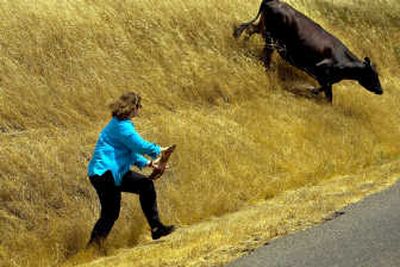Drive-by shootings of livestock on rise

PETALUMA, Calif. – The buzzards led Nick Bursio to his prized calf. He found the body with a bullet hole in its left shoulder, near the heart.
Bursio had heard of animals killed by rustlers for their meat. But not until that May morning had he imagined anything so senseless as shooting cattle just to watch them die.
“I had a hollow feeling in my gut, to see that dead calf laying there, with the mother cow bellowing nearby,” said the Sonoma County rancher. “I thought, what the hell’s going on in this place?”
Authorities are hunting a drive-by shooter who guns down cows as they calmly munch grass in the rolling pastureland 50 miles north of San Francisco. Since February, five cows have been found dead in two counties, shot with small-caliber bullets designed to inflict prolonged pain and suffering.
Nationwide, an increasing number of animal-cruelty cases are being reported outside city limits: Horses, cows, goats and other farm animals are being killed, authorities say, often by angry, reckless young people, perhaps acting on dares.
While there are no statistics on such crimes, newspapers detail scores of cases.
Two Texas college students were indicted in 2006 for slashing a horse’s neck before stabbing it in the heart with a broken golf club handle.
In Pennsylvania in 2005, three joy-riding men killed a pony named “Ted E. Bear” that belonged to a 4-year-old boy.
In 2006, two Tennessee teenagers shot and killed 24 cows, many of them pregnant.
“They just wanted to see what shooting cattle was like,” Hickman County Sheriff Randal Ward said.
California also has seen its share of the rural violence. In addition to the Northern California cattle shootings, Oakland police are investigating the May murder of 15 goats, shot in the face as they huddled in a portable pen. Officers said residents had called in to report the sound of “babies crying.”
Fresno County detectives arrested two groups of teens in 2005 in the shooting of two dozen cows and horses.
In 2003, two Sonoma County men used their cars to ram to death a horse named Gentle Song.
Still, the murder of large farm animals garners little attention in America, where the loudest outcry is reserved for the killing of suburban pets. While 43 states have passed felony animal-cruelty laws, they rarely are applied to livestock as long as ranchers follow “accepted husbandry practices,” thanks in part to a strong cattleman’s lobby.
“Animals raised commercially for food have little legal protection against cruelty,” said Gene Baur, president of Farm Sanctuary, a group that campaigns against cruelty to farm animals. “It speaks to a prejudice against certain animals, not based on a rational assessment of their ability to feel pain but on our intended use for them.”
Studies suggest that youths who engage in animal cruelty often commit violent criminal behavior as adults. Among those who preyed on animals before people were mass killers Jeffrey Dahmer, Ted Bundy and Albert DeSalvo, the “Boston Strangler.”
The random killing of large animals suggests a troubling psychology experts are only beginning to understand. Even when caught, many youths refuse to talk about their crimes.
“When you do get to talk to kids and ask why they did it, the most common response is that they were bored,” said Randall Lockwood, vice president for Anti-Cruelty Initiatives at the American Society for the Prevention of Cruelty to Animals. “They’re obviously troubled. Most bored teens shoot hoops or go see movies; they don’t go out shooting horses and cows.”
Still, researchers are developing a personality profile of large-animal killers. Abusers who target livestock act out a different motivation than those who pick on smaller creatures, said Mary Lou Randour, national director of human-animal relations for the Humane Society of the United States.
“Driving around in search of animals to kill is very planned and methodical, which could make it more pathological and dangerous. These animals could be standbys for the real thing: a human being,” she said.
In January, a 16-year-old Humboldt County teenager was sentenced to 15 years in prison for the killing of a homeless man. Earlier, that same night, the teen fired a dozen shots into a cow, hitting it in the face and eye and cutting off an ear, authorities said.
Such violence preoccupies Cindy Machado, a Marin County Humane Society detective. Combing country roads in her animal-control truck, she pursues rancher Bursio’s cattle killer.
In May, after Bursio found his dead 600-pound Charolais heifer, Machado got on the phone to Fresno County, where detectives solved a series of farm animal killings in 2005. She says the cases are similar: “They combine guns and kids and back roads. It’s a disaster waiting to happen.”